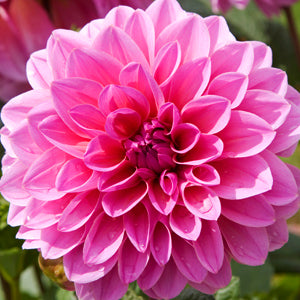The last month of spring is upon us, and November is a fantastic time to get in the garden and plant some beautiful flowers for summer! Australia is a massive country, so here is a list of plants for each state and territory. As many states have similar climate conditions (and conditions can also vary dramatically across each state), be sure to check if this flower may suit your local area.
Tasmania
Asters
Aster
.jpg)
Asters are a beautiful addition to any perennial garden and bloom beautifully in white, blue, pink and purple. They attract bees, butterflies, and other pollinators, as they provide a fantastic feeding opportunity. When picking asters, take into account height, colour, and flowering time.
Select a site with partial to full sun and moist, well-drained soil. For the best results, fertilise soil before in advance, water a lot when planting and mulch afterwards. Asters are great in climates with cool, moist summers and cool nights, making Tasmania the perfect place. Asters will do well across Australia, except for wet/dry tropical areas and arid inland regions – unfortunately this means if you’re anywhere in the NT you should probably give asters a miss!
Queensland
Dahlia
Dahlia
.jpg)
Dahlias come in a range of brilliant, bright colours! They can be grown across Australia, except for in dry, inland areas. If you’re in a cold area, wait until frosts have finished and the soil has warmed up after winter before planting. Be sure to plant in areas with rich, well-drained soil. Also pick a spot which offers protection from winds and full sunlight – 6 to 8 hours of direct light every day is ideal.
Northern Territory
Chrysanthemum
Chrysanthemum
.jpg)
Chrysanthemums, often referred to as “garden mums”, are gorgeous herbaceous perennials. They’ll grow everywhere but in dry inland areas – so if you’re in inland NT, check out WA’s zinnias for a great plant that will suit your conditions! Spring, after any danger of winter frosts has passed, is a great time to plant. Chrysanthemums need around six weeks to establish in the ground before they can withstand extreme hot or cold weather. However, mums can be planted at any time of the year. They like fertile, sandy or loamy, soil and it’s important that soil is well-drained and water collection around the stems is avoided.
Western Australia
Zinnia
Zinnia.jpg)
Zinnias come in a wide range of colours, although most are warm toned: deep red and mahogany, orange, pink and yellow. They will grow right across Australia, even in very dry areas. Zinnias like to be positioned in full sun with long, warm summers, and dislike cold winds and sudden weather changes. Whilst moist, well-drained soil is perfect, zinnias can withstand very dry periods, making them perfect for inland areas!
New South Wales
Verbena
Verbena
.jpg)
Verbena is a great choice if you want blooming flowers during hot summer months. Verbena needs a lot of sun, between eight and 10 hours each day, and well-draining soil. The quality of the soil is not so important, as verbena will grow even in poor soil. Verbena comes in perennial and annual varieties, and unfortunately perennials often die when planted in soggy soil following heavy snow or rain. Particularly suited to temperate, subtropical and wet/dry tropical areas, verbena grows well on the northern, eastern and southern coasts of Australia. Top tip – if you’re in an area with humid summers, opt for perennial verbena, it will bloom more spectacularly in summer!
Victoria
Iceland Poppy
Papaver nudicaule
.jpg)
With over 80 different varieties, the Iceland poppy comes in white, yellow and red, as well as varying heights (usually around 60cm tall and wide). Iceland poppies provide a pop of colour, and their flowers are long-lasting. Beyond being beautiful, Iceland poppies attracts birds, butterflies and bees, making them a functional addition to the garden. They should be grown in light, well-drained soil and exposed to full sunlight. Iceland poppies thrive in temperate areas, which covers much of Australia’s south coast from southern Queensland to WA.
South Australia
Sage
Salvia
.jpg)
Salvia is a spectacular perennial and a great addition to any garden. It grows well across Australia, and blooms in abundance throughout spring and summer in even the hottest and coldest conditions. Saliva is easy to care for and relativly low-maintenance, but make sure it gets full sun and well-drained soil. It also attracts butterflies and bees, making it not only stunning but very handy to have around!
Australian Capital Territory
Hollyhock
Alcea
.jpg)
Hollyhocks are striking flowers, and you can be forgiven for mistaking them for hibiscus – they’re part of the same family, after all. Hollyhocks need moist, rich, well-drained soil. Plating them in soil that is too dry is a very common mistake. Also make sure they exposed to full sun. Hollyhocks can have tall stalks, so if strong winds are common in your area be sure to plant them out of the way, or use strong supports. Hollyhocks are particularly suited to cool climates, making them great choices for Canberra, Melbourne, Tasmania and cool highland areas.









